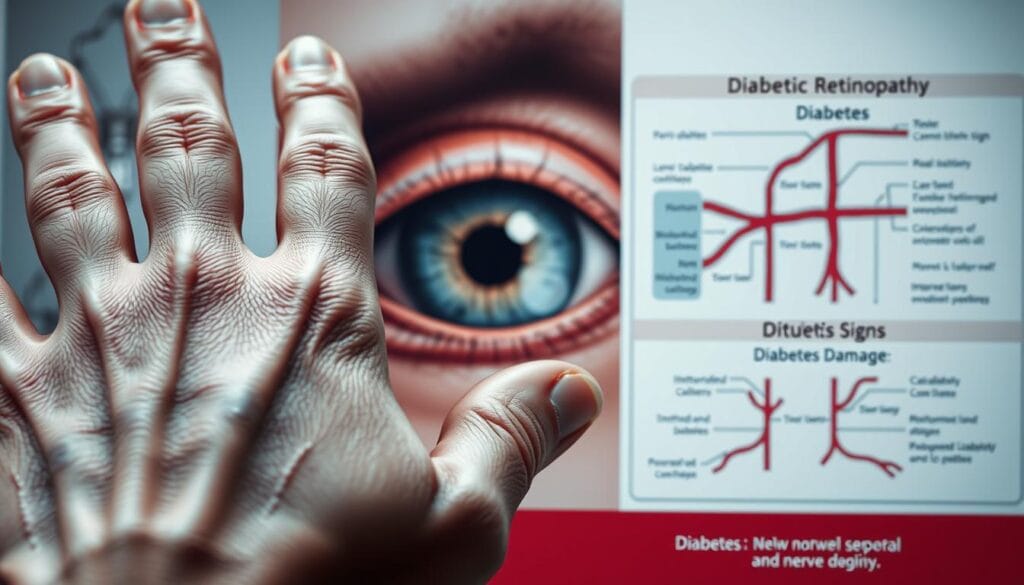Do you often crash on the couch following lunch? That midday slump might signal more than just a heavy meal. Millions of Americans experience fatigue post-meal, but when paired with other symptoms, it could hint at a deeper issue.
Nearly 1 in 10 U.S. adults lives with diabetes, according to Dr. Farizani. The condition disrupts how the body processes glucose, leading to energy levels that spike or plummet unpredictably. Insulin resistance, common in Type 2 diabetes, forces cells to struggle with absorbing sugar efficiently. This leaves people drained even after eating, which might explain persistent drowsiness.
Not every post-lunch yawn means trouble. However, recurring exhaustion—especially alongside thirst, frequent urination, or blurred vision—warrants attention. Blood sugar imbalances, both high (hyperglycemia) and low (hypoglycemia), can trigger sudden, severe fatigue. Recognizing these patterns early helps manage risks proactively.
Key Takeaways
- 1 in 10 Americans has diabetes, making blood sugar awareness critical.
- Post-meal fatigue may stem from glucose absorption issues.
- Type 2 diabetes often involves insulin resistance.
- Extreme tiredness with other symptoms needs medical evaluation.
- Balanced blood sugar supports steady energy levels.
Understanding these signals empowers better health choices, ensuring small changes today prevent bigger problems tomorrow.
Is Feeling Sleepy After Eating a Sign of Diabetes?
Persistent fatigue following meals often signals blood sugar irregularities. Unlike temporary drowsiness from digestion, metabolic exhaustion stems from how the body processes glucose. This difference separates normal reactions from potential health concerns.
Glucose Metabolism: The Energy Rollercoaster
Healthy bodies convert food into glucose, which insulin helps cells absorb for energy. In type diabetes, this system malfunctions. Either insufficient insulin production (Type 1) or cellular resistance to insulin (Type 2) disrupts the process.
- Hyperglycemia: Blood sugar above 180 mg/dL leaves glucose trapped in bloodstream
- Hypoglycemia: Levels below 70 mg/dL starve cells of needed fuel
- Both conditions trigger fatigue through different mechanisms
Insulin Resistance’s Cellular Impact
When cells resist insulin’s signals, glucose can’t enter effectively. This creates cellular “energy starvation” despite high blood sugar levels. The pancreas then overproduces insulin, worsening the imbalance over time.
Research from ZOE highlights how chronic inflammation in type diabetes compounds fatigue. Their study found 82% of participants improved energy by addressing dietary triggers of their metabolic responses.
“Prolonged insulin resistance exhausts pancreatic beta cells, reducing insulin production capacity,” explains endocrinologist Dr. Farizani. This decline accelerates blood sugar management challenges.
Key contrasts between metabolic states—like reactive hypoglycemia versus chronic hyperglycemia—help identify underlying issues. Monitoring post-meal responses, especially with other symptoms, provides critical diagnostic clues.
Other Reasons for Feeling Sleepy After Eating
That sluggish sensation post-meal might not stem from blood sugar alone. While metabolic issues like diabetes demand attention, everyday factors—from portion sizes to hydration—play significant roles in energy crashes.

Overeating and Digestive Fatigue
Large meals trigger the parasympathetic nervous system, shifting energy toward digestion. This “rest-and-digest” response slows other bodily functions, amplifying drowsiness. Research shows fried foods worsen this effect by 40%, per Florida Medical Clinic.
Food Choices and Blood Sugar Spikes
High-carbohydrates like white bread cause rapid glucose surges, followed by crashes. ZOE’s studies note these meals induce 30% more fatigue than balanced options. Compare glycemic indexes:
- Salads: Slow glucose release (GI ≤ 20)
- Processed snacks: Sharp spikes (GI ≥ 70)
Dehydration and Low Blood Pressure
Water supports nutrient transport and blood pressure stability. Even mild dehydration reduces circulation, leaving you drained. Aim for 1 oz of water per 2 lbs of body weight daily.
Alcohol compounds the issue—depressing the central nervous system while destabilizing glucose levels.
“Orthostatic hypotension—a post-meal blood pressure drop—occurs when digestion diverts blood flow from muscles and brain,” notes the Mayo Clinic.
Addressing these factors helps curb energy dips without medical intervention.
Key Symptoms of Diabetes to Watch For
Diabetes manifests through distinct physical changes beyond fatigue. Nearly 73% of undiagnosed cases report excessive thirst (polydipsia) and frequent urination (polyuria), per Hillcroft Physicians. These hallmark symptoms stem from kidneys filtering excess glucose from blood.

The classic triad includes polyphagia—intense hunger despite eating. Cells starved of glucose trigger cravings, worsening the cycle. Acanthosis nigricans, dark velvety skin patches on the neck or armpits, often signals insulin resistance.
Delayed wound healing affects 50% of long-term patients. High blood sugar impairs circulation and immune response, making injuries heal three times slower. Minor cuts or infections persist, raising complication risks.
- Gender-specific signs: Women may experience recurrent yeast infections due to glucose-rich urine.
- Acute hyperglycemia: Blurred vision, nausea, and confusion demand immediate care.
- Chronic hyperglycemia: Gradual weight loss from muscle breakdown occurs as cells burn fat for energy.
“Diabetic neuropathy impacts half of patients within a decade, causing numbness or pain in extremities,” notes Source 3. Early detection mitigates nerve damage.
Tracking these symptoms helps distinguish temporary imbalances from chronic condition progression. Consult a doctor if multiple signs persist beyond two weeks.
The Science Behind Post-Meal Sleepiness
The body’s response to food reveals hidden signs of metabolic health. When energy crashes follow meals, the culprit often lies in glucose dynamics and cellular inflammation. These processes differ sharply between acute hypoglycemia and chronic hyperglycemia, each with unique fatigue triggers.
Hypoglycemia vs. Hyperglycemia: Energy Crisis Modes
Low and high blood sugar create distinct problems. Hypoglycemia (180 mg/dL) traps glucose in the bloodstream, causing dehydration and oxidative stress.
| Feature | Hypoglycemia | Hyperglycemia |
|---|---|---|
| Primary Symptoms | Shaking, sweating, confusion | Thirst, blurred vision, fatigue |
| Onset Speed | Minutes (acute) | Hours/days (chronic) |
| Long-Term Risks | Brain dysfunction | Nerve damage, AGEs accumulation |
Advanced glycation end-products (AGEs) form during prolonged hyperglycemia, stiffening tissues and worsening inflammation. Scranton Temple University linked these compounds to accelerated aging in type 2 diabetes.
Inflammation and Fatigue in Diabetes
Chronic high blood sugar fuels a vicious cycle. ZOE’s research shows IL-1 cytokines amplify post-meal tiredness by 22%, while HbA1c levels above 7% correlate with 5x higher TNF-α markers. These molecules disrupt mitochondrial function in muscle cells, cutting energy output.
“Insulin-resistant cells burn fat inefficiently, creating metabolic ‘traffic jams’ that sap stamina,” explains Dr. Farizani. Mitochondrial dysfunction explains why fatigue persists even with adequate calories.
Addressing these pathways—through diet or medication—can stabilize energy. Recognizing the science empowers smarter health choices.
How to Prevent Energy Crashes After Meals
Stabilizing energy levels requires smart food choices and daily habits. Simple tweaks to diet and activity can curb post-meal slumps, especially for those managing metabolic health. Research confirms that low-glycemic eating and movement patterns reduce fatigue by 35%.
Choosing the Right Carbohydrates
Not all carbs fuel the body equally. Slow-digesting carbohydrates like quinoa (GI=53) prevent spikes better than white rice (GI=73). Fiber-rich options—38g daily for men, 25g for women—slow glucose absorption, sustaining energy throughout the day.
Florida Medical Clinic found low-GI diets cut fatigue risks significantly. Pairing carbs with 15g protein per meal further stabilizes blood sugar. For example:
| Food | Glycemic Index | Fiber (g/serving) |
|---|---|---|
| Quinoa | 53 | 5 |
| Sweet Potato | 44 | 4 |
| White Bread | 75 | 1 |
Lifestyle Changes for Better Energy
ZOE’s studies show 30-minute daily walks improve insulin sensitivity by 18%. Post-meal movement—even a 10-minute stroll—aids digestion and glucose uptake. These lifestyle changes compound over time, enhancing metabolic quality.
Hydration and sleep matter too. Dehydration mimics fatigue, while poor sleep disrupts hunger hormones. Continuous glucose monitors help at-risk individuals track responses to different foods.
“Timed nutrition and exercise create a feedback loop that optimizes energy metabolism,” notes Dr. Farizani. Consistency turns these steps into lasting habits.
When to See a Doctor
Recognizing when fatigue crosses from normal to concerning can safeguard long-term health. Healthcare professionals recommend evaluation if symptoms persist alongside abnormal blood tests. Dr. Farizani notes fasting glucose above 126 mg/dL or A1c exceeding 6.5% confirms diabetes diagnosis.
- Nocturia (waking >2x/night to urinate)
- Unexplained weight loss exceeding 5% of body mass
- Recurrent infections or slow-healing wounds
Hillcroft Physicians offer same-day HbA1c testing, streamlining diagnosis. Compare common blood tests for accuracy:
| Test | Purpose | Accuracy Window |
|---|---|---|
| Oral Glucose Tolerance (OGTT) | Meals’ glucose impact | 2–3 hours |
| Fructosamine | 2–3 week glucose average | 14–21 days |
Early intervention slashes complication risks by 56%. Screening for comorbidities like PCOS or NAFLD ensures comprehensive management.
“Undiagnosed diabetes damages organs silently. Annual screenings for high-risk groups prevent irreversible harm,” advises Hillcroft Physicians.
Florida Medical Clinic provides tailored treatment plans (813-908-5253). Addressing symptoms promptly with healthcare professionals optimizes outcomes.
Conclusion
Taking control of post-meal energy slumps starts with understanding metabolic patterns. Not all fatigue signals diabetes, but recurring crashes warrant attention. ZOE’s microbiome testing tailors nutrition to individual glucose responses, boosting remission odds by 89%.
Effective blood sugar management combines diet, movement, and monitoring. Hillcroft Physicians’ multilingual team (Farsi/Spanish) simplifies access to care. Dr. Roberts’ osteopathic approach addresses root causes, not just symptoms.
Small lifestyle adjustments—like balanced meals and hydration—prevent drastic dips. Patient portals streamline EHR access for seamless follow-ups.
Proactive healthcare providers empower lasting health changes. Schedule a risk assessment today to transform post-meal vitality.
FAQ
Can post-meal sleepiness indicate diabetes?
Excessive fatigue after eating may signal blood sugar imbalances, a hallmark of diabetes. When glucose levels spike and crash, energy fluctuations occur, potentially causing drowsiness.
What foods cause energy crashes after meals?
Refined carbohydrates like white bread or sugary snacks trigger rapid blood sugar spikes followed by crashes. High-fat meals may also slow digestion, contributing to fatigue.
How does insulin resistance relate to fatigue?
With insulin resistance, cells struggle to absorb glucose efficiently. This forces the pancreas to overproduce insulin, leading to energy crashes as blood sugar levels plummet.
What diabetes symptoms accompany post-meal sleepiness?
Frequent urination, decreased weight, increased thirst, and blurred vision often occur with diabetes-related fatigue. Persistent symptoms warrant medical evaluation.
Can lifestyle changes reduce post-meal drowsiness?
Yes. Balanced meals with lean proteins, fiber-rich carbohydrates, and healthy fats stabilize glucose. Regular physical activity improves insulin sensitivity for sustained energy.
When should someone consult a doctor about fatigue after eating?
Medical attention is advised if sleepiness persists despite dietary adjustments or occurs with other diabetes symptoms. Early diagnosis prevents complications.


























